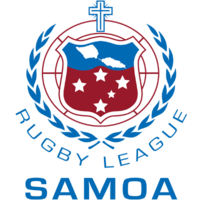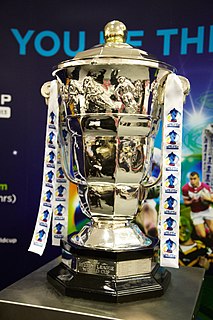
The Cook Islands national rugby league team has been participating in international rugby league football competition since 1986. The team is controlled by the governing body for rugby league in Cook Islands, Cook Islands Rugby League Association (CIRLA), which is currently a member of the Asia-Pacific Rugby League Confederation (APRLC). They are currently ranked 23rd in the RLIF World Rankings.

The Samoa national rugby league team represents Samoa in rugby league football and has been participating in international competition since 1986. Known as Western Samoa prior to 1997, the team is administered by Rugby League Samoa and are nicknamed Toa Samoa.
The South Africa national rugby league team are a rugby league football team that represents South Africa. South Africa to date have competed at two Rugby League World Cups in 1995 and 2000 but have failed to win a game in the competition.

Rugby World Cup qualification is a process that determines which nations will compete at the Rugby World Cup.
For the 1991 Rugby World Cup, 16 nations participated in the finals tournament, half of which came through qualifying matches, and the other were granted automatic entry as they were quarter-finalists at the 1987 Rugby World Cup. The 25 teams taking part in regional qualifiers together with the 8 teams which qualified automatically brings to 33 the total number of teams participating in the 1991 Rugby World Cup.

The Rugby League World Cup is an international rugby league tournament, contested by national teams of the Rugby League International Federation, which was first held in France in 1954, the first World Cup in either rugby code. The idea of a rugby league World Cup tournament was first mooted in the 1930s with the French proposal to hold a tournament in 1931, and again in 1951. The fifteen tournaments held to date have been at intervals ranging from two to eight years, and have featured a number of formats. So far three nations have won the competition. Australia, France and New Zealand are the only teams to have played in all tournaments. Since 2000, the RLIF has also organised World Cups for women, students and other categories. The 2017 Rugby League World Cup was held in Australia, New Zealand and Papua New Guinea which was won by Australia.

2011 Rugby World Cup qualifying began at the 2007 tournament in France, where twelve teams earned a place in the finals of the tournament, this automatically qualified them for the 2011 Rugby World Cup in New Zealand.
2000 Rugby League World Cup qualifying was contested by the national rugby league football teams of Lebanon, the United States, Morocco, Canada, Italy and Japan for the 16th spot in the 2000 Rugby League World Cup tournament. Lebanon won the tournament and went on to the World Cup.

The most popular sport in Oceania varies from country to country. The most popular sport in Australia is cricket, the most popular sport among Australian women is netball, while Australian rules football is the most popular sport in terms of spectatorship and television ratings. Rugby is the most popular sport among New Zealanders. In Papua New Guinea, the most popular sport is the Rugby league.

The 2017 Rugby League World Cup was the fifteenth staging of the Rugby League World Cup tournament and took place in Australia, New Zealand and Papua New Guinea between 27 October and 2 December 2017. The tournament featured the national teams of 14 Rugby League International Federation member countries who qualified through either standing in the previous tournament or a series of qualification play-off matches. In the final, defending champions Australia, playing in their 14th consecutive final, defeated England at Brisbane's Lang Park.
Of the fourteen teams that would participate in the 2013 Rugby League World Cup, only two were not automatic inclusions, so must win qualifying matches to enter the tournament, which was held in Wales and England. Originally around twenty teams were to be involved in qualification for the tournament, but this was eventually fixed at nineteen.
The Federation of Oceania Rugby Unions (FORU) section of the 2015 Rugby World Cup qualification involved five teams competing for one spot in the final tournament in England.

The 2018 ICC Cricket World Cup Qualifier was a cricket tournament that took place during March 2018 in Zimbabwe. It decided the final qualification for the 2019 World Cup in England and Wales. The top two teams, Afghanistan and the West Indies, qualified for the World Cup, joining the hosts and the seven teams who had already qualified through their ranking in the ICC ODI Championship. Afghanistan won the tournament, beating the West Indies by 7 wickets in the final. Afghanistan's Mohammad Shahzad was named the player of the match and Zimbabwe's Sikandar Raza was named the player of the tournament.
The 2017 Rugby League World Cup Asia-Pacific qualification play-off was a rugby league match that was played on 17 October 2015 at Campbelltown Stadium in Australia. Tonga defeated the Cook Islands 28-8 to qualify for the 2017 Rugby League World Cup.
The 2017 Rugby League World Cup Europe qualification was a rugby league tournament held in October and November 2016 to decide the three European qualifiers for the 2017 Rugby League World Cup.

The qualification process for the 2019 Rugby World Cup in Japan began during the pool stages of the 2015 tournament in England, during which the top three teams from each of the four pools were awarded automatic qualification for the 2019 event. A further eight teams qualified through regional, cross-regional tournaments and the repechage process.
The qualification process for the 2017 Women's Rugby World Cup began on 14 February 2015. Twelve teams qualified for the tournament, which was held in Ireland in 2017.
Oceania Rugby Women’s Championship is an international women's rugby union competition contested by women's national teams from Oceania.
The 2021 Rugby League World Cup qualifying process began in June 2018 with the commencement of the 2018 Rugby League European Championship C tournament. Of the 16 nations that will compete in the World Cup, eight were granted automatic qualification, having reached the quarter finals of the 2017 World Cup. The remaining eight places were decided through a qualifying process.
The qualification process for the 2021 Rugby World Cup began on 9 August 2019 with 12 teams qualifying to the tournament which will be held in New Zealand.








